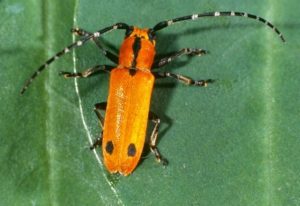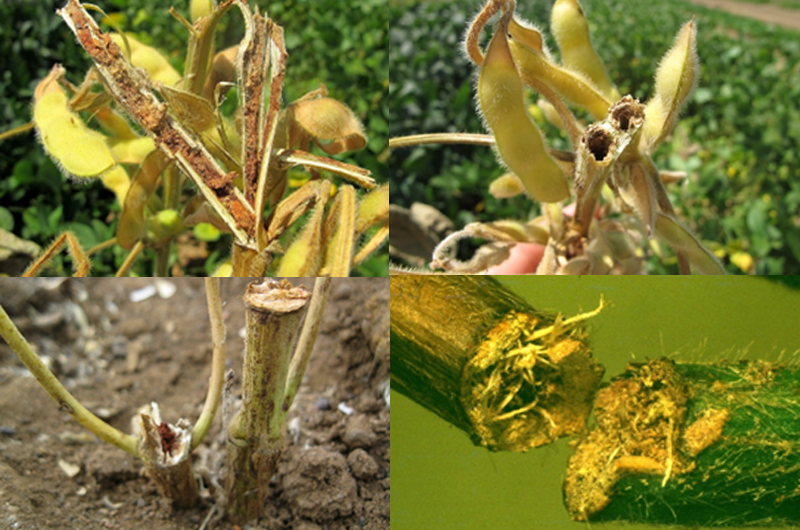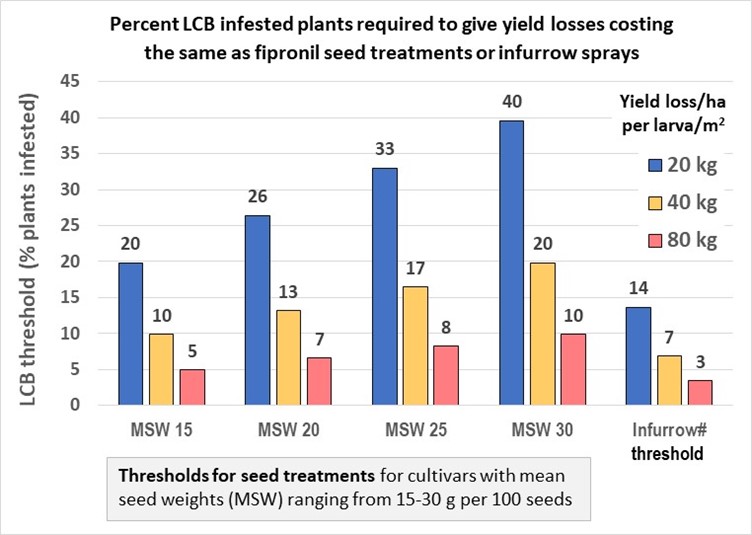
- Extension of expiry date to 30 September 2025
- Addition of a re-entry statement and S161 statement
- Adjustments to the protection statement
- Moving spray drift to a separate statement
- Updating the additional conditions.
The permit covers using either 322.5 mL/ha of fipronil products containing 20% active or 80g/ha of products containing 80% active, with both options giving a field application of about 64 mL of fipronil per hectare.
PER88226 complements the recently issued PER88231 (valid until 31 July 2024) for fipronil as a seed treatment in soybeans (@ 200 mL/100 kg seed). Note that in-furrow sprays of fipronil cannot be used if the seed has already been treated with fipronil.
Why is LCB an issue?
Lucerne crown borers spend a large portion of their lifecycle out of reach of contact sprays.
While the stem-boring larvae are unlikely to cause major yield losses while they are tunnelling in the pith, larvae nearing pupation ringbark the plant’s stem internally and plug the stem’s pith canal to create an overwintering chamber in the tap root.
If this girdling occurs before podfill there are obvious yield losses. But losses can still occur when pods are fully filled, as weakened girdled stems frequently lodge, placing them out of reach of harvesters. Side branches can also lodge when their bases are weakened by larvae tunnelling down to reach the main stem.

Examples of LCB damage to soybean stems
How do I decide if it’s worth applying fipronil?
Prophylactic management decisions are best based on previous LCB history in the paddock and surrounding area and the predicted temperatures for the coming summer (e.g. severe LCB damage is more likely in a hot El Niño summer than in a cooler cloudy La Niña summer).
Because of the nature of LCB infestations, a typical economic threshold is not appropriate, however, a general guide can be calculated. The easiest method is to consider your past experience with this pest and determine the percent of plants infested, relative size of the pods/seeds in girdled plants, and typical yield loss.
The impact of an LCB infestation depends on i) the percentage of plants infested and ii) the yield loss per infested plant/larva. Larvae are cannibalistic and normally only one larva per plant survives to overwinter.
Yield loss depends on how early plant girdling commences. If most of your crop’s infested plants have typically been girdled by early pod fill, the yield loss (per larva/m2) could potentially approach 80 kg/ha. But if most infested plants have not been girdled until pods are ≥80% filled, the yield loss is much lower.
If the rate of LCB damage in your crops and local area fluctuates widely, you might be more inclined to make a decision based on the average potential yield losses, say 40 kg per larva/m2.
Figure 1 below expresses LCB thresholds as the percent plants infested to give yield losses costing an amount equal to the cost of a fipronil seed treatment (or an in-furrow spray), for scenarios where the rate of damage per larva/m2 is 20, 40 or 80 kg/ha per larva/m2.

Figure 1: Thresholds for lucerne crown borer (LCB) expressed as % of plants infested where the value of likely yield losses equals the cost of a fipronil seed treatment, or the cost of an in-furrow spray.
These thresholds are based on a soybean price of $600/t, a plant density of 30 plants per square metre, a fipronil seed treatment formulation costing $790/L and ranging from $71-$142/ha, depending on planting seed size, and an in-furrow formulation costing $50/ha.
Note that the seed treatment thresholds are higher for larger seeded cultivars (e.g. Bunya), than for smaller seeded cultivars. This is because the seed treatment permit rate is set at 200 mL per 100 kg of seed, and consequently the rates and costs per ha increase proportionally as mean seed weight increases. In contrast, in-furrow spray rates are set a flat rate per hectare and are thus unaffected by planting seed size.
Other considerations
Fipronil is currently under review by the APVMA and continued issuance of these permits will depend on the review’s outcome.
To minimise fipronil use, consider these non-insecticide strategies to reduce LCB impact:
- Avoid planting successive soybean crops in the same paddock
- Avoid planting soybeans adjacent to other LCB hosts (such as lucerne) and control soybean volunteers and weed hosts (e.g. sesbania or phasey bean).
- Strip till infested soybean stubble—breaking stubble open and burying it reduces the survival of overwintering LCB
- Use irrigation to reduce plant stress where possible, particularly from early podfill onwards. Moisture stress can trigger premature formation of pupal chambers by LCB larvae. Obviously, the earlier this occurs the greater the yield loss.
- Ensure solid plant stands. Adjoining plants will help prevent LCB girdled plants from falling over at harvest.
If historically you regularly suffer severe LCB damage, seed treatments will most likely be justified. But on average, if the typical damage you experience is very low, then seed treatments are probably not justified, particularly for large-seeded cultivars. The lower price of in-furrow sprays may be attractive, even if they are not quite as effective as seed treatments.
Remember that non-insecticide management options are not only IPM-friendly, they provide a plan B should fipronil ever be withdrawn by the APVMA due to environmental concerns.
Download the permits from the APVMA:
